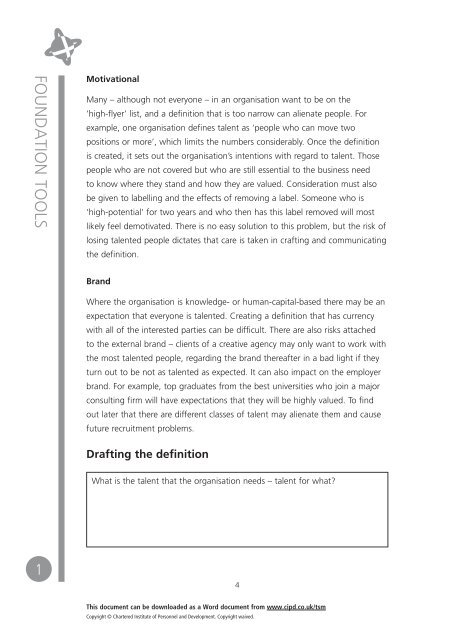Talent Management and Succession Planning - CIPD
Talent Management and Succession Planning - CIPD
Talent Management and Succession Planning - CIPD
You also want an ePaper? Increase the reach of your titles
YUMPU automatically turns print PDFs into web optimized ePapers that Google loves.
Foundation tools<br />
1<br />
Motivational<br />
many – although not everyone – in an organisation want to be on the<br />
‘high-flyer’ list, <strong>and</strong> a definition that is too narrow can alienate people. for<br />
example, one organisation defines talent as ‘people who can move two<br />
positions or more’, which limits the numbers considerably. once the definition<br />
is created, it sets out the organisation’s intentions with regard to talent. those<br />
people who are not covered but who are still essential to the business need<br />
to know where they st<strong>and</strong> <strong>and</strong> how they are valued. Consideration must also<br />
be given to labelling <strong>and</strong> the effects of removing a label. Someone who is<br />
‘high-potential’ for two years <strong>and</strong> who then has this label removed will most<br />
likely feel demotivated. there is no easy solution to this problem, but the risk of<br />
losing talented people dictates that care is taken in crafting <strong>and</strong> communicating<br />
the definition.<br />
Br<strong>and</strong><br />
where the organisation is knowledge- or human-capital-based there may be an<br />
expectation that everyone is talented. Creating a definition that has currency<br />
with all of the interested parties can be difficult. there are also risks attached<br />
to the external br<strong>and</strong> – clients of a creative agency may only want to work with<br />
the most talented people, regarding the br<strong>and</strong> thereafter in a bad light if they<br />
turn out to be not as talented as expected. it can also impact on the employer<br />
br<strong>and</strong>. for example, top graduates from the best universities who join a major<br />
consulting firm will have expectations that they will be highly valued. to find<br />
out later that there are different classes of talent may alienate them <strong>and</strong> cause<br />
future recruitment problems.<br />
Drafting the definition<br />
what is the talent that the organisation needs – talent for what?<br />
This document can be downloaded as a Word document from www.cipd.co.uk/tsm<br />
Copyright © Chartered Institute of Personnel <strong>and</strong> Development. Copyright waived.<br />
A sample from <strong>Talent</strong> <strong>Management</strong> <strong>and</strong> <strong>Succession</strong> <strong>Planning</strong> 2nd Edition by James A Cannon<br />
<strong>and</strong> Rita McGee. Published by the <strong>CIPD</strong>. Copyright <strong>CIPD</strong> © 2010. All rights reserved. No part<br />
of this excerpt may be reproduced, stored in a retrieval system, or transmitted, in any form<br />
or by any means, electronic, mechanical, photocopying, recording, or otherwise. www.cipd.<br />
co.uk/Bookstore<br />
4

















